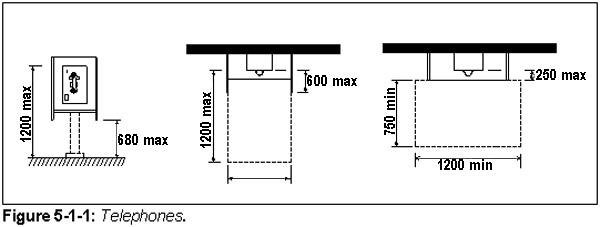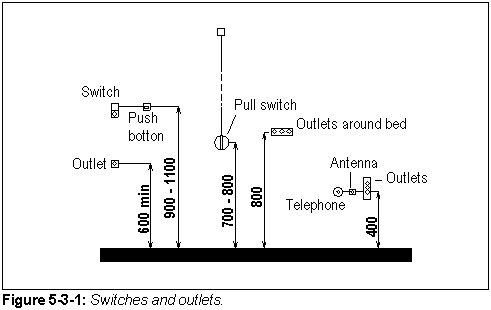Communications and Services
Dimensional Considerations (0)
Circulation (1.1 - 1.11)
Public Amenities (2.1 - 2.4)
Transport (3.1 - 3.5)
Residential (4.1 - 4.7)
Title: Communications Systems |
5.1 |
| Application | General | Urban Application | Information Technology | Rural Application | Safety | |||
| External Environment | Public Building | Housing | Public Transport | |||||
| Physical | . | . | . | . | . | X | . | . |
| Visual | . | . | . | . | . | X | . | . |
| Hearing | . | . | . | . | . | . | . | . |
| Intellectual | . | . | . | . | . | . | . | . |
Recommendation:
Public Telephones
- Sufficient floor or ground space for a forward or parallel approach by a wheelchair user should be provided near telephone booths (Fig. 5-1-1).
- Cubicle doors and fixed seats should not block approaches to and from telephones for people who use wheelchairs. As an alternative to fixed seats, folding seats may be provided in telephone booths.
- The highest part of a telephone should be within reach of a seated person.
- Knee space should be provided under telephones.
- Telephones should have push button controls.
- A long cord from the telephone to the handset should be provided.
- It is highly recommended that telephones have "hands-free" receivers.
Telecommunication Devices for Deaf Persons (TDD)
- Telecommunications devices for deaf persons (TDD) should be installed adjacent to pay-phone booths.
- TDD should be identified by the "TDD" symbol.
- Pay-phones should be hearing-aid compatible.
- Pay-phones should have volume controls.
- Visual Notification Devices should be provided in offices, workplaces, hotel rooms and homes to alert hearing-impaired persons to in-coming telephone calls.
Assistive Listening Devices
- Assembly areas, as well as conference and meeting rooms should provide assistive listening devices for persons with hearing impairments.
- Various types of assistive listening systems are available on the market. They include audio-induction loops, radio frequency systems and infrared transmission devices.
- Assistive listening devices should be available for use in:
- - Theatres, concert halls, auditoriums, stadiums and other places of cultural activity;
- - Museums, galleries and other places for public display;
- - Zoos and amusement parks.
Facsimile
- Facsimile machines are a valuable communication tool for persons with hearing impairments and should be readily available to them in post offices, commercial areas, public places and in their homes.
Sign Language Interpretation
- Adequate lighting, raised platforms and headphone sets should be provided for sign language interpreters.
Braille
- Braille symbols and/or text in raised format should be provided in places frequented by persons with visual impairments.
- Text/symbols and the background of all signs should have a non-glare finish. They need to be in sharp contrast to their background.
- "Talking signs" should be installed.
Reference figure:

Title: Alarm Systems |
5.2 |
| Application | General | Urban Application | Information Technology | Rural Application | Safety | |||
| External Environment | Public Building | Housing | Public Transport | |||||
| Physical | . | . | . | . | . | . | . | . |
| Visual | . | . | . | . | . | X | . | X |
| Hearing | . | . | . | . | . | X | . | X |
| Intellectual | . | . | . | . | . | . | . | . |
Recommendation:
- Concerning vocal alarms, vibrating alarms and instructions for escape from danger:
- If emergency warning systems, e.g. vibrating alarms or vocal alarms, are installed, they should include a means of warning for visually impaired persons.
- Visual alarm devices should be provided for persons with hearing impairments.
- Sockets should be provided near beds to allow alarm systems, including vibrating under-pillow devices, to be connected easily.
Title: Switches and Outlets |
5.3 |
| Application | General | Urban Application | Information Technology | Rural Application | Safety | |||
| External Environment | Public Building | Housing | Public Transport | |||||
| Physical | . | . | X | X | . | . | X | . |
| Visual | . | . | . | . | . | . | . | . |
| Hearing | . | . | . | . | . | . | . | . |
| Intellectual | . | . | . | . | . | . | . | . |
Recommendation:
- Switches and outlets should be mounted at an appropriate height and position for easy reach by wheelchair users.
Reference figure:

Title: Lighting |
5.4 |
| Application | General | Urban Application | Information Technology | Rural Application | Safety | |||
| External Environment | Public Building | Housing | Public Transport | |||||
| Physical | . | . | . | . | . | . | . | . |
| Visual | X | X | X | X | X | . | X | X |
| Hearing | X | X | X | X | X | . | X | X |
| Intellectual | . | . | . | . | . | . | . | . |
Recommendation:
- Adequate and well distributed lighting should be installed. Glare from excessively bright lights should be avoided.
- Staircases should have adequate lighting.
Go back to the Contents
ECONOMIC AND SOCIAL COMMISSION FOR ASIA AND THE PACIFIC
Promotion of Non-Handicapping Physical Environments for Disabled Persons: Guidelines
- ANNEX 2(5) -
UNITED NATIONS
New York, 1995
